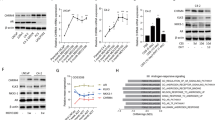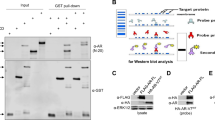Abstract
Androgen receptor (AR) plays an important role in the development and progression of prostate cancer upon the action of androgen through the binding of the androgen-responsive elements (AREs) on the target genes. Abnormal activation of the AR by nonandrogen has been implicated in the progression of androgen-independent prostate cancer. The levels of interleukin-4 (IL-4) are significantly elevated in sera of patients with hormone refractory prostate cancer. The potential role of IL-4 on the activation of AR was investigated in prostate cancer cells. IL-4 enhances AR-mediated prostate-specific antigen (PSA) expression and ARE-containing gene activity through activation of the AR in the androgen ablation condition in human prostate cancer cells. The AR can also be sensitized by IL-4 and activated by significantly lower levels of androgen (10 pM of R1881) in prostate cancer cells. IL-4 enhances nuclear translocation of AR and increases binding of the AR to the ARE in LNCaP prostate cancer cells. Blocking of the Akt pathway by an Akt-specific inhibitor LY294002 abrogates IL-4-induced PSA expression and AR signaling. These results demonstrate that IL-4 enhances PSA expression through activation of the AR and Akt signaling pathways in LNCaP prostate cancer cells. Understanding IL-4-induced signaling leading to abnormal activation of AR will provide insights into the molecular mechanisms of androgen-independent progression of prostate cancer cells.
This is a preview of subscription content, access via your institution
Access options
Subscribe to this journal
Receive 50 print issues and online access
$259.00 per year
only $5.18 per issue
Buy this article
- Purchase on Springer Link
- Instant access to full article PDF
Prices may be subject to local taxes which are calculated during checkout








Similar content being viewed by others
Change history
01 October 2021
An Editorial Expression of Concern to this paper has been published: https://doi.org/10.1038/s41388-021-02034-7
Abbreviations
- IL-4:
-
interleukin-4
- AR:
-
androgen receptor
- ARE:
-
androgen response element
- PSA:
-
prostate specific-antigen
- Stat:
-
signal transducers and activators of transcription
- MAPK:
-
mitogen-activated protein kinase
- PI3 K:
-
phosphatidylinositol (PI) 3-kinase
- HF:
-
hydroxyflutamide
- CS-FBS:
-
charcoal-stripped fetal bovine serum
References
Barrack ER . (1996). Mt. Sinai J. Med., 63, 403–412.
Chen T, Wang LH and Farrar WL . (2000). Cancer Res., 60, 2132–2135.
Coffman RL, Ohara J, Bond MW, Carty J, Zlotnik A and Paul WE . (1986). J. Immunol., 136, 4538–4541.
Craft N, Shostak Y, Carey M and Sawyers CL . (1999). Nat. Med., 5, 280–285.
Culig Z, Hobisch A, Cronauer MV, Radmayr C, Trapman J, Hittmair A, Bartsch G and Klocker H . (1994). Cancer Res., 54, 5474–5478.
Dudley DT, Pang L, Decker SJ, Bridges AJ and Saltiel AR . (1995). Proc. Natl. Acad. Sci., USA, 92, 7686–7689.
Gascan H, Gauchat JF, Roncarolo MG, Yssel H, Spits H and de Vries JE . (1991). J. Exp. Med., 173, 747–750.
Godoy-Tundidor S, Hobisch A, Pfeil K, Bartsch G and Culig Z . (2002). Clin. Cancer Res., 8, 2356–2361.
Hobisch A, Culig Z, Radmayr C, Bartsch G, Klocker H and Hittmair A . (1995). Cancer Res., 55, 3068–3072.
Hobisch A, Eder IE, Putz T, Horninger W, Bartsch G, Klocker H and Culig Z . (1998). Cancer Res., 58, 4640–4645.
Isaacs JT . (1994). Vitam. Horm., 49, 433–502.
Isaacs JT . (1999). Urol. Clin. North Am., 26, 263–273.
Johnston JA, Kawamura M, Kirken RA, Chen YQ, Blake TB, Shibuya K, Ortaldo JR, McVicar DW and O'Shea JJ . (1994). Nature, 370, 151–153.
Lin DL, Whitney MC, Yao Z and Keller ET . (2001). Clin. Cancer Res., 7, 1773–1781.
Linja MJ, Savinainen KJ, Saramaki OR, Tammela TL, Vessella RL and Visakorpi T . (2001). Cancer Res., 61, 3550–3555.
Meydan N, Grunberger T, Dadi H, Shahar M, Arpaia E, Lapidot Z, Leeder JS, Freedman M, Cohen A, Gazit A, Levitzki A and Roifman CM . (1996). Nature, 379, 645–648.
Murata T, Noguchi PD and Puri RK . (1996). J. Immunol., 156, 2972–2978.
Nelms K, Keegan AD, Zamorano J, Ryan JJ and Paul WE . (1999). Annu. Rev. Immunol., 17, 701–738.
Onate SA, Boonyaratanakornkit V, Spencer TE, Tsai SY, Tsai MJ, Edwards DP and O'Malley BW . (1998). J. Biol. Chem., 273, 12101–12108.
Pang S, Dannull J, Kaboo R, Xie Y, Tso CL, Michel K, deKernion JB and Belldegrun AS . (1997). Cancer Res., 57, 495–499.
Sadar MD . (1999). J. Biol. Chem., 274, 7777–7783.
Seder RA and Paul WE . (1994). Annu. Rev. Immunol., 12, 635–673.
Shimoda K, van Deursen J, Sangster MY, Sarawar SR, Carson RT, Tripp RA, Chu C, Quelle FW, Nosaka T, Vignali DA, Doherty PC, Grosveld G, Paul WE and Ihle JN . (1996). Nature, 380, 630–633.
Smerz-Bertling C and Duschl A . (1995). J. Biol. Chem., 270, 966–970.
Sun XJ, Wang LM, Zhang Y, Yenush L, Myers Jr MG, Glasheen E, Lane WS, Pierce JH and White MF . (1995). Nature, 377, 173–177.
Tilley WD, Buchanan G, Hickey TE and Bentel JM . (1996). Clin. Cancer Res., 2, 277–285.
Trapman J and Cleutjens KB . (1997). Semin. Cancer Biol., 8, 29–36.
Ueda T, Bruchovsky N and Sadar MD . (2001). J. Biol. Chem., 19, 19.
van der Kwast TH, Schalken J, Ruizeveld de Winter JA, van Vroonhoven CC, Mulder E, Boersma W and Trapman J . (1991). Int. J. Cancer, 48, 189–193.
Vitetta ES, Ohara J, Myers CD, Layton JE, Krammer PH and Paul WE . (1985). J. Exp. Med., 162, 1726–1731.
Wang LM, Myers Jr MG, Sun XJ, Aaronson SA, White M and Pierce JH . (1993). Science, 261, 1591–1594.
Wen Y, Hu MC, Makino K, Spohn B, Bartholomeusz G, Yan DH and Hung MC . (2000). Cancer Res., 60, 6841–6845.
Wise GJ, Marella VK, Talluri G and Shirazian D . (2000). J. Urol., 164, 722–725.
Witthuhn BA, Silvennoinen O, Miura O, Lai KS, Cwik C, Liu ET and Ihle JN . (1994). Nature, 370, 153–157.
Yeh S, Lin HK, Kang HY, Thin TH, Lin MF and Chang C . (1999). Proc. Natl. Acad. Sci. USA, 96, 5458–5463.
Zhou MM, Huang B, Olejniczak ET, Meadows RP, Shuker SB, Miyazaki M, Trub T, Shoelson SE and Fesik SW . (1996). Nat. Struct. Biol., 3, 388–393.
Acknowledgements
We thank Dr Chawnshang Chang, University of Rochester, for the gift of AR expression vector.
Author information
Authors and Affiliations
Corresponding author
Additional information
This research was supported by grants from NIH CA90271 and US Army Medical Research Materiel Command AMRMC Prostate Cancer Research Program Grant DAMD17-01-1-0089
Rights and permissions
About this article
Cite this article
Lee, S., Lou, W., Hou, M. et al. Interleukin-4 enhances prostate-specific antigen expression by activation of the androgen receptor and Akt pathway. Oncogene 22, 7981–7988 (2003). https://doi.org/10.1038/sj.onc.1206735
Received:
Revised:
Accepted:
Published:
Issue Date:
DOI: https://doi.org/10.1038/sj.onc.1206735
Keywords
This article is cited by
-
Editorial Expression of Concern: Interleukin-4 enhances prostate-specific antigen expression by activation of the androgen receptor and Akt pathway
Oncogene (2021)
-
Germline variants in IL4, MGMT and AKT1 are associated with prostate cancer-specific mortality: An analysis of 12,082 prostate cancer cases
Prostate Cancer and Prostatic Diseases (2018)
-
Androgen receptor signaling in prostate cancer
Cancer and Metastasis Reviews (2014)
-
Mechanisms of persistent activation of the androgen receptor in CRPC: recent advances and future perspectives
World Journal of Urology (2012)
-
Phosphoinositide 3-OH kinase p85α and p110β are essential for androgen receptor transactivation and tumor progression in prostate cancers
Oncogene (2008)



